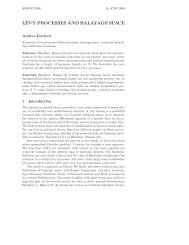Degenerate parabolic stochastic partial differential equations
Degenerate parabolic stochastic partial differential equations
Degenerate parabolic stochastic partial differential equations
You also want an ePaper? Increase the reach of your titles
YUMPU automatically turns print PDFs into web optimized ePapers that Google loves.
4328 M. Hofmanová / Stochastic Processes and their Applications 123 (2013) 4294–4336<br />
Proposition 4.14. The process ˜W is an ( F˜<br />
t )-cylindrical Wiener process, i.e. there exists a<br />
collection of mutually independent real-valued ( F˜<br />
<br />
t )-Wiener processes { ˜β k } k≥1 such that ˜W =<br />
k≥1 ˜β k e k .<br />
Proof. Hereafter, fix K ∈ N, times 0 ≤ s 1 < · · · < s K ≤ s ≤ t, s, t ∈ D, continuous functions<br />
γ : C [0, s]; H −1 (T N ) × C [0, s]; U 0<br />
<br />
−→ [0, 1], g : R K −→ [0, 1]<br />
and test functions ψ 1 , . . . , ψ K ∈ C 0 (T N × R) and θ 1 , . . . , θ K ∈ C([0, T ]) such that supp θ i ⊂<br />
[0, s i ], i = 1, . . . , K . For notational simplicity, we write g( ˜m) instead of<br />
g ˜m(θ 1 ψ 1 ), . . . , ˜m(θ K ψ K ) <br />
and similarly g( ˜m n ) and g(m n ). By ϱ s we denote the operator of restriction to the interval [0, s]<br />
as introduced in (38).<br />
Obviously, ˜W is a U 0 -valued cylindrical Wiener process and is ( F˜<br />
t )-adapted. According to the<br />
Lévy martingale characterization theorem, it remains to show that it is also a ( F˜<br />
t )-martingale. It<br />
holds true<br />
Ẽ γ ϱ s ũ n , ϱ s ˜W n g( ˜m n ) ˜W n (t) − ˜W n (s) = E γ ϱ s u n , ϱ s W g(m n ) W (t) − W (s) = 0<br />
since W is a martingale and the laws of (ũ n , ˜W n ) and (u n , W ) coincide. Next, the uniform<br />
estimate<br />
sup<br />
n∈N<br />
Ẽ∥ ˜W n (t)∥ 2 U 0<br />
= sup E∥W (t)∥ 2 U 0<br />
< ∞<br />
n∈N<br />
and the Vitali convergence theorem yields<br />
Ẽ γ ϱ s ũ, ϱ s ˜W g( ˜m) ˜W (t) − ˜W (s) = 0<br />
which finishes the proof.<br />
□<br />
Proposition 4.15. The processes<br />
˜M(t),<br />
˜M 2 (t) − k≥1<br />
t<br />
indexed by t ∈ D, are ( ˜ F t )-martingales.<br />
0<br />
<br />
δũ=ξ g k , ϕ t<br />
2 <br />
dr, ˜M(t) ˜β k (t) − δũ=ξ g k , ϕ dr,<br />
Proof. All these processes are ( F˜<br />
t )-adapted as they are Borel functions of ũ and ˜β k , k ∈ N, up<br />
to time t. For the rest, we use the same approach and notation as the one used in the previous<br />
lemma. Let us denote by ˜β<br />
k n, k ≥ 1 the real-valued Wiener processes corresponding to ˜W n , that<br />
is ˜W n = k≥1 ˜β k ne k. For all n ∈ N, the process<br />
M n =<br />
·<br />
0<br />
<br />
δu n =ξ Φ n (u n )dW, ϕ = k≥1<br />
·<br />
0<br />
<br />
δu n =ξ g n k , ϕ dβ k (r)<br />
is a square integrable (F t )-martingale by (2) and by the fact that the set {u n ; n ∈ N} is bounded<br />
in L 2 (Ω; L 2 (0, T ; L 2 (T N ))). Therefore<br />
(M n ) 2 − k≥1<br />
·<br />
0<br />
<br />
δu n =ξ g n k , ϕ 2 dr,<br />
M n β k −<br />
·<br />
0<br />
0<br />
<br />
δu n =ξ g n k , ϕ dr



